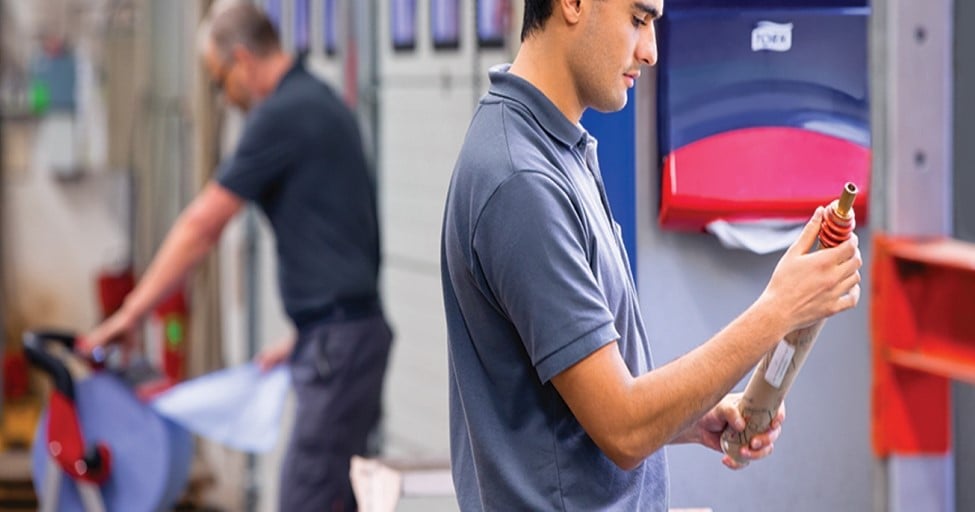Protecting employee's health and safety while maximizing productivity is crucial for manufacturers deploying and maintaining proper cleaning protocol. In manufacturing, COVID-19 has had a significant impact on hygiene protocols and facilities adapted quickly to meet dynamic new requirements. However, hygiene protocol can’t come at the expense of production as facilities are a vital part of supply chains and ensure consistent delivery of essential goods.
Facilities now need to invest and adapt their approach to hygiene, cleaning, and ultimately productivity. An improved workflow, one that incorporates cleaning, hygiene, and productivity, is possible with the Japanese concept of “kaizen.” “Kai” means change and “zen” means better, the core principles of kaizen require all aspects of the workplace to be continually improving.
A kaizen-based approach fosters positive change, an agile work environment and encourages new ways of approaching productivity that promotes employee engagement and confidence. This relates to productivity in manufacturing facilities. By implementing kaizen-inspired practices, your facility can achieve a culture of continuous improvement – starting with a plan for preventive maintenance – that amplifies productivity.
Kaizen principles can be leveraged in several ways to enhance preventative maintenance:
Preventive Maintenance
The philosophy of kaizen is grounded in staying dynamic and implementing changes on an ongoing basis. According to Tork research, 87 percent of employees say preventive maintenance reduces machine breakdowns and lost production time. Facilities should take a dynamic approach to update their preventive maintenance routines to ensure employees are regularly carrying out tasks that will reduce the risk of potential problems before they cause downtime. Preventive maintenance can address standard operational issues such as leakage, dirt contamination, and improve access checkpoints on an ongoing basis, allowing facilities to continuously improve and achieving productivity metrics with small ongoing checks.
Cleaning Efficiency Optimization
Another element of kaizen is making incremental changes that can have a big impact, such as ongoing cleaning checks throughout an employee’s shift. While preventive maintenance is critical, employees can optimize efficiency with a continuous approach to cleaning.
Using task-based cleaning products is key to optimizing ongoing cleaning routines. Changing protocol doesn’t have to be resource-intensive. As many as 89 percent of machine operators agree that having robust, professional industrial wiper dispensers placed exactly where they are needed would support efficient cleaning and preventive maintenance.
Facilities have an opportunity to listen and act on this feedback. One helpful upgrade is to use wiper and cloth dispensers that have flexible mounting options, so they can be placed at mission-critical parts of the facility – providing employees with easy access right where they need it most. Facility managers can also provide the most effective cloths and wipers based on the task to be performed – from multipurpose wiping papers to advanced heavy-duty cleaning cloths – for even better results.
However, it can be difficult to know what’s right for a specific facility. Third-party workplace consultations are one way to become aware of new cleaning solutions that work best for specific environments. Small efforts to support continuous cleaning can have a significant impact on a facility’s production quality, cost, and delivery. With these measures in place, implementing employee feedback will help achieve a culture of kaizen.
Employee Engagement
Organizational buy-in and empowering employees are critical components of kaizen. Leaders should seek out employee input to create positive change as it shows employees that their contributions are valued, and it can also generate real benefits for facilities.
Employees who work in operations can identify the key areas of improvement required. By creating forums for consistent and transparent employee feedback, leadership can better understand where employees have identified opportunities for improvement. Subsequently, implementing changes based on dialogue shows employees their suggestions are heard.
One key learning is that 89% of machine operators believe it is easier to inspect and detect faults on a clean machine. In this case, leadership can work with employees to uncover what additional products or increases in maintenance routines are needed to achieve a higher level of cleanliness that also allows for more productivity. Following this, managers can encourage them to autonomously maintain equipment, so they have a better chance of discovering problems before they result in downtime. This builds a sense of employee ownership of their work, and it will also improve overall morale and productivity.
For further ideas on how to implement a kaizen-inspired culture of continuous improvement, download the Tork Equipped to Improve™ guide.





